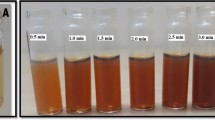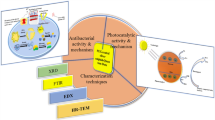Abstract
Silver nanoparticles decorated on nanotubes morphology of Bismuth doped manganese oxide (Bi-MnOx) was prepared by Triton-X-100 polymer assisted precipitation process. In the second step, Ag nanoparticle with very fine particle size and graphene nanoparticle deposition by high power ultra-sonication method. Biogenic route synthesized silver nanoparticles have forms the spherical particle morphology with particle size obtained <10 nm. Polymer assisted method prepared pristine Bi-MnOx has existing in Nano- tubular morphology. The nanotube formation/nano particle incorporation has clearly confirmed by Scanning and Transmision electron microgph images. The synthesized silver nanoparticle modified Bi-MnOx composite was further tested for non-enzymatic detection of hydrogen peroxide sensor application. To exploit the biological activity of as prepared Bi-MnOx and biogenic route prepared silver quantum dot (QDs) particle and graphene oxide (GO) modified Bi-MnOx nanocomposite was further studied for gram positive and gram-negative bacterial strain. The nanoparticle dispersed Bi-MnOx could be adopted as low cost coating materials in health care smart building construction. Diffuse reflectance spectral studies are described for as prepared Ag QDs/GO doped Bi-MnOx is shown reduced band gap values (2.93 eV) than the pristine Bi-MnOx (3.17 eV) and it could be adopted for visible light photo-catalysis and antimicrobial applications.

Highlights
-
Silver nanoparticles with quantum dot particles are produced by the biogenic route.
-
Ag QDs incorporated on Bi- MnOx nanotubes show effective porous texture.
-
Ag QD and GO are inserted into the tubular morphology of Bi-MnOx.
-
Ag@Bi-MnOx and Bi-MnOx show effective antibacterial activity.
-
Ag@Bi-MnOx and Ag-Bi-MnOx/GO show promising sensor activity.











Similar content being viewed by others
References
Yang S, Liu L, Wang G et al. (2015) One-pot synthesis of Mn3O4 nanoparticles decorated with nitrogen-doped reduced graphene oxide for sensitive nonenzymatic glucose sensing. JEAC 755:15–21. https://doi.org/10.1016/j.jelechem.2015.07.021
Abecassis-Wolfovich M, Jothiramalingam R, Landau MV et al. (2005) Cerium incorporated ordered manganese oxide OMS-2 materials: Improved catalysts for wet oxidation of phenol compounds. Appl Catal B Environ 59:91–98. https://doi.org/10.1016/j.apcatb.2005.01.001
Gnana kumar G, Awan Z, Suk Nahm K, Stanley Xavier J (2014) Nanotubular MnO2/graphene oxide composites for the application of open air-breathing cathode microbial fuel cells. Biosens Bioelectron 53:528–534. https://doi.org/10.1016/j.bios.2013.10.012
Rather SU (2019) Hydrogen uptake of manganese oxide-multiwalled carbon nanotube composites. Int J Hydrog Energy 325–331. https://doi.org/10.1016/j.ijhydene.2018.03.009
Da Costa-Serra JF, Chica A (2018) Catalysts based on Co-Birnessite and Co-Todorokite for the efficient production of hydrogen by ethanol steam reforming. Int J Hydrog Energy 43:16859–16865. https://doi.org/10.1016/j.ijhydene.2017.12.114
Wang Y, Bai W, Nie F, Zheng J (2015) A non-enzymatic glucose sensor based on Ni/MnO2 nanocomposite modified glassy carbon electrode. 2399–2405. https://doi.org/10.1002/elan.201500049
Tang C, Zhang Y, Han J, et al. (2020) Monitoring graphene oxide’s efficiency for removing Re(VII) and Cr(VI) with fluorescent silica hydrogels. Environ Pollut 262:. https://doi.org/10.1016/j.envpol.2020.114246
Wilk ŁJ, Ciechanowska A, Kociołek-Balawejder E (2020) Removal of sulfides from water using a hybrid ion exchanger containing manganese(IV) oxide. Sep Purif Technol 231. https://doi.org/10.1016/j.seppur.2019.115882
Zhou H, Xu J, Lv S, et al. (2020) Removal of cadmium in contaminated kaolin by new-style electrokinetic remediation using array electrodes coupled with permeable reactive barrier. Sep Purif Technol 239: https://doi.org/10.1016/j.seppur.2020.116544
Dung NT, Thu TV, Van Nguyen T et al. (2020) Catalytic activation of peroxymonosulfate with manganese cobaltite nanoparticles for the degradation of organic dyes. RSC Adv 10:3775–3788. https://doi.org/10.1039/c9ra10169a
Ding B, Zheng P, Ma P, Lin J (2020) Manganese oxide nanomaterials: synthesis, properties, and theranostic applications. Adv Mater 32: https://doi.org/10.1002/adma.201905823
Asif M, Aziz A, Quang A et al. (2015) Analytica chimica acta real-time tracking of hydrogen peroxide secreted by live cells using MnO2 nanoparticles intercalated layered doubled hydroxide nanohybrids. Anal Chim Acta 898:34–41. https://doi.org/10.1016/j.aca.2015.09.053
Shypunov I, Kongi N, Kozlova J et al. (2015) Enhanced oxygen reduction reaction activity with electrodeposited Ag on manganese oxide–graphene supported electrocatalyst. Electrocatalysis 6:465–471. https://doi.org/10.1007/s12678-015-0266-x
Lv Q, Sun H, Li X et al. (2016) Ultrahigh capacitive performance of three-dimensional electrode nanomaterials based on α-MnO2 nanocrystallines induced by doping Au through Å-scale channels. Nano Energy 21:39–50. https://doi.org/10.1016/j.nanoen.2015.11.009
Bahloul A, Nessark B, Briot E et al. (2013) Polypyrrole-covered MnO2 as electrode material for supercapacitor. J Power Sources 240:267–272. https://doi.org/10.1016/j.jpowsour.2013.04.013
Hoseinpour V, Ghaemi N (2018) Green synthesis of manganese nanoparticles: applications and future perspective–A review. J Photochem Photobio B Biol 189:234–243. https://doi.org/10.1016/j.jphotobiol.2018.10.022
Jadhav S, Kalubarme RS, Terashima C et al. (2019) Manganese dioxide/reduced graphene oxide composite an electrode material for high-performance solid state supercapacitor. Electrochim Acta 299:34–44. https://doi.org/10.1016/j.electacta.2018.12.182
Liu Q, Yang J, Luo X et al. (2020) Fabrication of a fibrous MnO2@MXene/CNT electrode for high-performance flexible supercapacitor. Ceram Int 46:11874–11881. https://doi.org/10.1016/j.ceramint.2020.01.222
Wang Y, Zhang D, Lu Y et al. (2019) Cable-like double-carbon layers for fast ion and electron transport: An example of CNT@NCT@MnO2 3D nanostructure for high-performance supercapacitors. Carbon NY 143:335–342. https://doi.org/10.1016/j.carbon.2018.11.034
Wang Q, Ma Y, Liang X et al. (2019) Flexible supercapacitors based on carbon nanotube-MnO2 nanocomposite film electrode. Chem Eng J 371:145–153. https://doi.org/10.1016/j.cej.2019.04.021
Ivanova AS, Slavinskaya EM, Mokrinskii VV et al. (2004) The role of support in formation of the manganese-bismuth oxide catalyst for synthesis of nitrous oxide through oxidation of ammonia with oxygen. J Catal 221:213–224. https://doi.org/10.1016/j.jcat.2003.06.001
Baidikova I, Matralis H, Naud J et al. (1992) Characterization of bismuth-manganese oxide catalysts for methane oxidative coupling. Appl Catal A, Gen 89:169–182. https://doi.org/10.1016/0926-860X(92)80231-Z
Minakshi M, Mitchell DRG (2008) The influence of bismuth oxide doping on the rechargeability of aqueous cells using MnO2 cathode and LiOH electrolyte. Electrochim Acta 53:6323–6327. https://doi.org/10.1016/j.electacta.2008.04.013
Zhu Q, Liu K, Zhou J et al. (2017) Design of a unique 3D-nanostructure to make MnO2 work as supercapacitor material in acid environment. Chem Eng J 321:554–563. https://doi.org/10.1016/j.cej.2017.03.147
Thiagarajan S, Tsai TH, Chen SM (2011) Electrochemical fabrication of nano manganese oxide modified electrode for the detection of H2O2. Int J Electrochem Sci 6:2235–2245
Daivajna MD, Kumar N, Gahtori B et al. (2014) Electrical conduction and thermal properties of Bi-doped Pr 0·7Sr0·3MnO3 manganite. Bull Mater Sci 37:47–51. https://doi.org/10.1007/s12034-014-0624-y
Daivajna MD, Kumar N, Awana VPS et al. (2014) Electrical, magnetic and thermal properties of Pr0.6-xBixSr0.4MnO3 manganites. J Alloy Compd 588:406–412. https://doi.org/10.1016/j.jallcom.2013.11.033
Ramalingam J, Vaali-Mohammed MA, Al-Lohedan HA, Appaturi JN (2017) Synthesis and bio-physical characterization of Silver nanoparticle and Ag-mesoporous MnO2 nanocomposite for anti-microbial and anti-cancer activity. J Mol Liq. https://doi.org/10.1016/j.molliq.2017.08.037
Jayaprakash N, Vijaya JJ, Kaviyarasu K, et al. (2017) Green synthesis of Ag nanoparticles using Tamarind fruit extract for the antibacterial studies. J Photochem Photobiol B Biol. https://doi.org/10.1016/j.jphotobiol.2017.03.013
Ramalingam J, Munusamy MA, Al-lohedan HA(2016) Preparation, textural and photoluminescence characterization of green fluorescence protein-immobilised Ga-ZnO (GZO) -nanocomposites J Photochem Photobiol B: Biol 165:202–212. https://doi.org/10.1016/j.jphotobiol.2016.10.028
Zhang X, Chen C, Chen X et al. (2019) Ruthenium oxide modified alpha-manganese dioxide nanotube as efficient bifunctional cathode catalysts for lithium oxygen batteries. ChemistrySelect 4:7455–7462. https://doi.org/10.1002/slct.201901744
Ray C, Dutta S, Roy A et al. (2016) Redox mediated synthesis of hierarchical Bi2O3/MnO2 nanoflowers: a non-enzymatic hydrogen peroxide electrochemical sensor. Dalt Trans 45:4780–4790. https://doi.org/10.1039/c6dt00062b
Vilas Bôas N, Souza Junior JB, Varanda LC et al. (2019) Bismuth and cerium doped cryptomelane-type manganese dioxide nanorods as bifunctional catalysts for rechargeable alkaline metal-air batteries. Appl Catal B Environ 258:118014
Chen R, Yu J, Xiao W (2013) Hierarchically porous MnO2 microspheres with enhanced adsorption performance. J Mater Chem A 1:11682–11690. https://doi.org/10.1039/c3ta12589k
Li L, Du Z, Liu S et al. (2010) A novel nonenzymatic hydrogen peroxide sensor based on MnO 2/graphene oxide nanocomposite. Talanta 82:1637–1641. https://doi.org/10.1016/j.talanta.2010.07.020
Pal U (2007) Use of diffuse reflectance spectroscopy for optical characterization of un-supported nanostructures. Rev Mex de F'is 53:18–22
Ranoszek-Soliwoda K, Tomaszewska E, Małek K et al. (2019) The synthesis of monodisperse silver nanoparticles with plant extracts. Colloids Surf B Biointerfaces 177:19–24. https://doi.org/10.1016/j.colsurfb.2019.01.037
Judith Vijaya J, Jayaprakash N, Kombaiah K, et al. (2017) Bioreduction potentials of dried root of Zingiber officinale for a simple green synthesis of silver nanoparticles: Antibacterial studies. J Photochem Photobiol B Biol. https://doi.org/10.1016/j.jphotobiol.2017.10.007
Palakurthy S, P AA, K VR (2019) In vitro evaluation of silver doped wollastonite synthesized from natural waste for biomedical applications. Ceram Int 45:25044–25051. https://doi.org/10.1016/j.ceramint.2019.03.169
Zhang X-F, Liu Z-G, Shen W, Gurunathan S (2016) Silver nanoparticles: synthesis, characterization, properties, applications, and therapeutic approaches. Int J Mol Sci 17. https://doi.org/10.3390/ijms17091534
Acknowledgements
We extend their appreciation to the Deputyship for Research & Innovation, “Ministry of Education” in Saudi Arabia for funding this research work through the project no. (IFKSURG-1440-014).
Authors Contribution
RJR: Supervision, Methodology; PA: Data curation, Formal analysis. HAA: Formal analysis, editing. TR: editing, Data curation, Formal analysis. AJN: Methodology, Conceptualization,. TP: analysis, writing, editing; MD W: Data collection, Methodology.
Author information
Authors and Affiliations
Corresponding author
Ethics declarations
Conflict of interest
The authors declare that they have no conflict of interest.
Additional information
Publisher’s note Springer Nature remains neutral with regard to jurisdictional claims in published maps and institutional affiliations.
Rights and permissions
About this article
Cite this article
Rajabathar, J.R., Arunachalam, P., AL-Lohedan, H.A. et al. Polymer surfactant (Triton-100) assisted low cost method for preparing silver and graphene oxide modified Bi-MnOx nanocomposite for enhanced sensor and anti-microbial health care applications. J Sol-Gel Sci Technol 97, 638–650 (2021). https://doi.org/10.1007/s10971-021-05468-3
Received:
Accepted:
Published:
Issue Date:
DOI: https://doi.org/10.1007/s10971-021-05468-3




